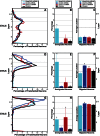Position of neocortical neurons transfected at different gestational ages with shRNA targeted against candidate dyslexia susceptibility genes
- PMID: 23724130
- PMCID: PMC3665803
- DOI: 10.1371/journal.pone.0065179
Position of neocortical neurons transfected at different gestational ages with shRNA targeted against candidate dyslexia susceptibility genes
Abstract
Developmental dyslexia is a language learning disorder that affects approximately 4-10% of the population. A number of candidate dyslexia susceptibility genes have been identified, including DCDC2 and KIAA0319 on Chromosome (Chr) 6p22.2 and DYX1C1 on Chr 15q21. Embryonic knockdown of the function of homologs of these genes in rat neocortical projection cell progenitors by in utero electroporation of plasmids encoding small hairpin RNA (shRNA) revealed that all three genes disrupted neuronal migration to the neocortex. Specifically, this disruption would result in heterotopia formation (Dyx1c1 and Kiaa0319) and/or overmigration past their expected laminar location (Dyx1c1 and Dcdc2). In these experiments, neurons normally destined for the upper neocortical laminæ were transfected on embryonic day (E) 15.5, and we designed experiments to test whether these migration phenotypes were the result of targeting a specific type of projection neuron. We transfected litters with Dcdc2 shRNA, Dyx1c1 shRNA, Kiaa0319 shRNA, or fluorescent protein (as a control) at each of three gestational ages (E14.5, E15.5, or E16.5). Pups were allowed to come to term, and their brains were examined at 3 weeks of age for the position of transfected cells. We found that age of transfection did not affect the percentage of unmigrated neurons--transfection with Kiaa0319 shRNA resulted in heterotopia formation at all three ages. Overmigration of neurons transfected with Dcdc2 shRNA, while present following transfections at the later ages, did not occur following E14.5 transfections. These results are considered in light of the known functions of each of these candidate dyslexia susceptibility genes.
Conflict of interest statement
Figures




References
-
- Harold D, Paracchini S, Scerri T, Dennis M, Cope N, et al. (2006) Further evidence that the KIAA0319 gene confers susceptibility to developmental dyslexia. Mol Psychiatry 11: 1085–1091, 1061. - PubMed
-
- Wilcke A, Weissfuss J, Kirsten H, Wolfram G, Boltze J, et al. (2009) The role of gene DCDC2 in German dyslexics. Annals of Dyslexia 59: 1–11. - PubMed
Publication types
MeSH terms
Substances
Grants and funding
LinkOut - more resources
Full Text Sources
Other Literature Sources
Miscellaneous

